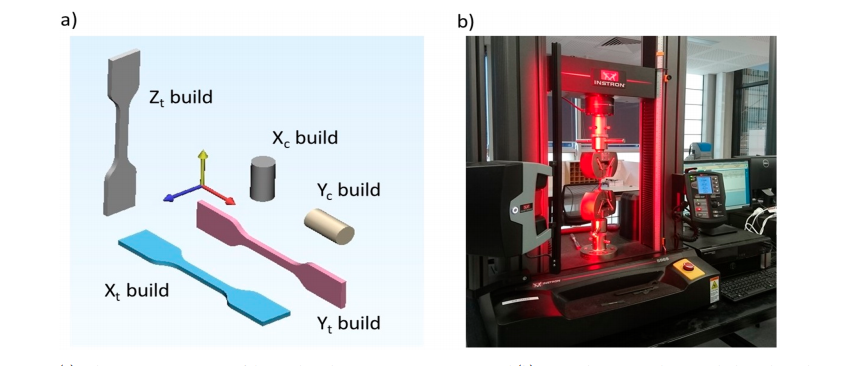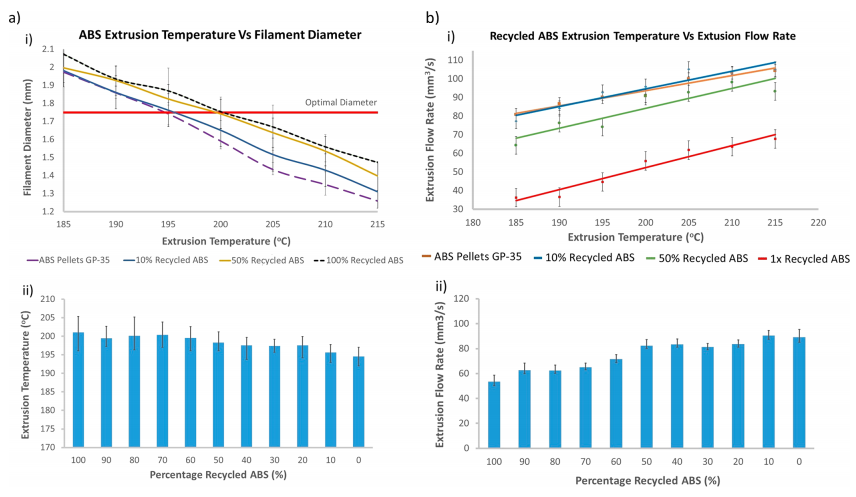3D Printing and ABS Recycling: Assessing Virgin and Re-used Filament
In the recently published ‘Investigation of closed loop manufacturing with Acrylonitrile Butadiene Styrene (ABS) over multiple generations using Additive Manufacturing,’ authors Mazher Iqbal Mohammed, Daniel Wilson, Eli Gomez-Kervin, Bin Tang, and Jinfeng Wang explore the impacts of FFF 3D printing on acrylonitrile butadiene styrene (ABS) during multiple recycling processes.
As 3D printing increases in popularity, so does the amount of discarded plastic. And while PLA is biodegradable, ABS is a typical plastic that is not—presenting environmental issues. In this study, the researchers hoped to explore FFF systems in regard to their low power consumption which may lend themselves to a path of greater manufacturing sustainability.
The researchers began using virgin ABS, put through two successive closed-loop filament extrusion and 3D printing phases. In this study they used 100 percent recycled 3D printed ABS, made into filament for re-use—allowing them to investigate parameters and potential for defects along the way.
“Studies have previously reported that changes in melt flow index and mechanical properties occur with ABS after recycling using injection and cast-molding,” stated the researchers. “However, to our best knowledge, no study has examined the influence of multiple closed-loop recycling phases using AM, where the grade of ABS and the thermal process regimes differ from manufacturing by molding processes.”
Virgin ABS pellets were extruded as filament and then 3D printed into parts. The researchers made sure to use plastic from one source only to make sure any differences would be directly comparable. Granules were produced in a uniform size, separated with a sieve with a mesh size of 5 mm.
“To determine the average pellet/granule size, 20 ABS pellets or granules were randomly collected from the source batch and their longest lengths were measured and averaged,” stated the researchers.

(a) Relative print orientations of the tensile and compression test coupons and (b) universal testing machine on which mechanical tests were performed.
While the study centered around the use of virgin ABS, the research team also experimented with one-time, two-time recycled ABS, as well as samples of 90, 80, 70, 60, 50, 40, 30, 20, and 10% virgin ABS. They assessed extrusion flow rate, 3D printing and characterization, polymer analysis, and mechanical property characterization.
In some cases, ‘nonuniformity of granules’ causes blockages, as well as ‘pinning’ because of sharp edges. The researchers tried agitating granules during extrusion to keep filament flowing correctly. Ultimately, the research team found that the FFF 3D printer performed very well with recycled ABS, and over multiple recycling generations too. They deemed the process successful and one that could indeed serve as a valid method of manufacturing with ‘several generations of use.’

(a) (i) A graph depicting the change in extruded filament diameter for changes in extrusion temperature; for clarity, only results for virgin,10% recycled, 50% recycled, and 100% recycled ABS are illustrated. (a) (ii) Temperature differences when extruding a respective ABS blend relative to obtain a filament diameter of 1.75 mm. (b) (i) Extrusion flow rate for various ABS blends comprising varying percentages of recycled to virgin material; for clarity, only results for virgin, 10% recycled, 50% recycled, and 100% recycled ABS are illustrated. (b) (ii) Extrusion flow rate for the various ABS blends when forming filaments with a diameter of 1.75 mm.
“Arguably, FFF has currently had its greatest commercial success in production of concept prototype devices by design companies or in the manufacturing of ornamental items such as toys and models, which generally have no strict mechanical strength requirements. Therefore, we believe that the use of recycled ABS of either one-time or two-times recycled variants could feasibly replace virgin polymer filaments in such applications, as the measured decline in mechanical strength would not impact the function of the end parts or prototypes,” concluded the researchers.
“FFF holds considerable potential for sustainable management of ABS plastics through its reintroduction into wider industrial manufacturing, potentially creating value from what is otherwise a growing burden to resource-recovery sites and landfill.”
ABS is one of the most popular 3D printing materials, for users on every level whether they are creating new materials and composites, refining issues with adhesion, or even making workstations. What do you think of this news? Let us know your thoughts! Join the discussion of this and other 3D printing topics at 3DPrintBoard.com.

Comparison in compressive stress for compression samples 3D printed using (a) virgin, (b) one-time recycled, and (c) two-times recycled ABS. (d) Summary of the compressive strain for the various ABS samples printed in the two spatial orientations. (e) Summary table of results for all compression test samples.
[Source / Images: ‘Investigation of closed loop manufacturing with Acrylonitrile Butadiene Styrene (ABS) over multiple generations using Additive Manufacturing’]
Subscribe to Our Email Newsletter
Stay up-to-date on all the latest news from the 3D printing industry and receive information and offers from third party vendors.
Print Services
You May Also Like
3D Printing Financials: Prodways Ends 2024 with a Profit
After a tough couple of years, Prodways (EPA: PWG) is starting to bounce back. The French 3D printing company finally made a profit in 2024, improved its operating performance, and...
Blue Origin & Auburn University Use EOS M290 to Study Copper 3D Printing
Blue Origin, the commercial space company built off of investments from Amazon founder Jeff Bezos, has donated two EOS M290 powder bed fusion (PBF) printers to Auburn University’s National Center...
Rocket Lab to Acquire Restructured Laser Communications Provider Mynaric AG
Rocket Lab USA, the Long Beach-based, end-to-end space services company that specializes in producing rockets with additive manufacturing (AM), has announced plans to acquire Mynaric AG, a German provider laser...
3D Printing Financials: Stratasys Ends 2024 with Cost Cuts and Growth Plans
Stratasys (Nasdaq: SSYS) has wrapped up 2024 with stronger margins but a full-year net loss. The polymer 3D printing leader navigated a year of economic headwinds, restructuring efforts, and shifting...



























